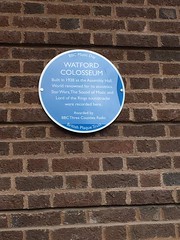Documenting the historical links between people and places as recorded by commemorative plaques
contribute
- You are all part of our mission to find all of the plaques in the world!
- Spotted one? Anyone can help us and add a plaque
- Take a photo. Add it to Wikimedia Commons or Flickr and link it to our record
- Spot an innaccuracy. Tell us.
Open Data
news
Follow us on Twitter and Facebook for updates.
Plaque Of The Day
Peter Cook and The Establishment (club) green plaque
Jez says, "I like this one because it has an unusual role on it. When I do a presentation about openplaques there is a slide showing lots of roles, and people always notice 'only twin'."
Place Of The Day
Norwich, United Kingdom
Norwich has a long history. It has been a city since 1094. From the Middle Ages until the Industrial Revolution, Norwich was the largest city in England after London and one of the most important. This is refelected in its plaques.
Most-viewed plaques
In the last 11 years, between 20 May 2009 to 6 Jan 2021, Open Plaques had 4,530,517 page views from 1,234,480 users. Some were triggered by internet memes such as Steve Ullathorne's 2012 image of a George Orwell plaque with a CCTV camera next to it. Others, such as those for Alan Turing, were probably triggered by an anniversary and campaign for recognition.
- George Orwell 1903-1950 novelist & political essayist lived here (19526 page views)
- Jacob von Hogflume 1864-1909 Inventor of time travel. lived here in 2189 (15077 page views)
- George Orwell 1903-1950 novelist and political essayist lived here (6390 page views)
- Jimi Hendrix 1942-1970 guitarist and songwriter lived here 1968-1969 (5714 page views)
- Alan Turing 1912-1954 founder of computer science and cryptographer, whose work was key to breaking the wartime Enigma codes, lived and died here. (4085 page views)
- Sir Arthur Conan Doyle 1859-1930 creator of Sherlock Holmes lived here 1891-1894 (3846 page views)
- Alan Turing 1912-1954 code breaker lived here from 1945-1947 (3679 page views)
- This building housed the offices of Charles Dickens' magazine 'All The Year Round' and his private apartments 1859-1870 (3339 page views)
- Dame Agatha Christie 1890-1976 detective novelist and playwright lived here 1934-1941 (3027 page views)
- The Peterloo Massacre. On 16th August 1819, a peaceful rally of 60,000 pro-democracy reformers, men, women and children was attacked by armed cavalry resulting in 15 deaths and over 600 injuries. (3006 page views)
recently photographed plaques
Hommage à Jean Drapeau En guise de reconnaissance à Me Jean Drapeau, maire de Montréal de 1954 à 1957 et de 1960 à 1986, grâce à qui le métro a vu le jour en 1966, et en souvenir d'Expo 67, une autre de ses grandes réalisations, les membres du conseil d'administration ont procédé, le 10 mai 2000, au changement de nom de la station Île-Sainte-Hélène par celui de Jean-Drapeau.
English translation:
Station Jean-Drapeau, métro de Montréal, Montreal, QC, Canada
TO THE MEMORY OF ALL THOSE CITIZENS OF SHEFFIELD BOTH MILITARY AND CIVILIAN WHO LOST THEIR LIVES AS RESULT OF WAR AND IN PURSUIT OF PEACE They shall not grow old as we that are left grow old Age shall not weary them nor the years condemn At the going down of the sun and in the morning We will remember them (Binyon 1869-1945)
Peace Gardens, Sheffield, United Kingdom
In memory of the crew of the Whitley V aircraft which crashed here on a training flight from RAF Abingdon, on 4 May 1941 Pilot Officer Charles Nairn Small, pilot, aged 23 Pilot Officer William Alexander Munro Halley, observer, aged 19 Sergeant John Alfred Mochan, wireless operator, aged 20 and of Frances Emma Hitchcox, local resident
Wolfson College, Oxford, United Kingdom
Texas Historical Marker #10315
Julia Ann Ragsdale Home. Widow of Dr. Frederick B. Ragsdale (1804-1851), Julia Ann Ragsdale (1821-1908) was a well-educated woman who taught school in Arkansas before she brought her family to Texas during the Civil War. In 1864 her daughter Mary Elizabeth (1843-1872) married Light Stapleton Townsend (1834-1928). After Mary's death, Mrs. Ragsdale moved to Wimberley in 1875 to raise her four grandchildren. Townsend built this board-and-batten home for them on Cypress Creek in 1879. Recorded Texas Historic Landmark - 1976 #10315
?, Wimberley, TX, United States
Subjects
Hier wohtne Flora Gross Geb. Bachrach Jg. 1891 Gedemütigt/entrechtet Flucht in den tod 3.3.1944
English translation:
Torstr. 223, Mitte, Berlin, Germany
Subjects
BBC Music Day 2017 #BBC East 7
Watford Colosseum Built in 1938 as the Assembly Hall. World renowned for its acoustics, Star Wars, The Sound of Music and Lord of the Rings soundtracks were recorded here. Awarded by BBC Three Counties Radio
Watford Colosseum, Watford, United Kingdom
Subjects
Josephine Butler 1828-1906 social reformer lived in 'The Priory' on this site
Wellington Mansions, London Road, Cheltenham, United Kingdom
Subjects
Malarinnan Helene Schjerfbeck f. 1862 d. 1946 bodde i denna gård 1925-1939
English translation: Helene Schjerfbeck of Malarinna f. 1862 d. 1946 bodde i denna gård 1925-1939 [AWS Translate]
Långgatan, Tammisaari, Finland
1-9 Muspole Street These 17th century houses in the heart of what was once the shoe industry in Norwich and behind the church of St. George's Colegate were first restored in the 1880s. Saved from demolition in 1969 for the extension of a car park at nearby Alms Lane they were converted to flats. Note the five large dormer windows, known as "luccams" or "lucarnes", a feature typical of the Norwich Street scene.
1-9 Muspole Street, Norwich, United Kingdom
Hier wohnte Martha Katz geb, Stern jg. 1891 deportiert 26.2.1943 Ermordet in Auschwitz
English translation: Martha Katz
Wullenweberstr. 11, Mitte, Berlin, Germany
Subjects
Texas Historical Marker #14456
Eleventh Texas Cavalry. In May 1861, a frontier unit was organized at Camp Reeves in Sherman. Drawing volunteers from Cooke, Grayson, Hopkins, Red River, Fannin, Collin, Titus and Bowie counties, the regiment began with nearly 900 men and officers. Initially led by the noted Col. William Cocke Young, the unit fought its first battles in Indian Territory, now Oklahoma, securing the territory for the Confederacy. In October of that year, the unit was inducted into Confederate service as the 11th Texas Cavalry and joined with other forces in Arkansas. Beginning in March 1862, at the Battle of Pea Ridge, or Elkhorn Tavern, the 11th Texas supported the Confederate Army. Following the battle, the unit became an infantry regiment, designated the 11th Texas Cavalry, Dismounted. For the remainder of the year, the troops were active in Mississippi, Tennessee and Kentucky. In early 1863, the 11th Texas fought at Murfreesboro, Tennessee, and shortly thereafter became a cavalry unit again. For the remainder of the war, the cavalry fought in Alabama, Georgia, South Carolina and North Carolina, participating in more than 100 battles and skirmishes. Notable engagements included Chickamauga, Knoxville, Dalton, Resaca, Allatoona Pass, Dallas/New Hope Church, Kennesaw Mountain, Atlanta, Savannah, and, finally, Bentonville, North Carolina. A small number of 11th Texas troops were present at the Confederate surrender at Durham Station, North Carolina, in April 1865. One of the most active Texas Confederate units, the 11th Texas Cavalry served with distinction throughout the Civil War, continuing until the last major Confederate offensive had ended. (2003) #14456
100 W. Houston St., Sherman, TX, United States





_Flora_Gross.jpg?width=250)





_Martha_Katz.jpg?width=250)


.jpg?width=250)